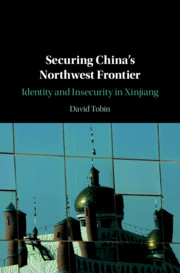Book contents
- Securing China’s Northwest Frontier
- Securing China’s Northwest Frontier
- Copyright page
- Dedication
- Contents
- Figures
- Abbreviations
- Introduction
- 1 Securing China on the Multi-Ethnic Frontier
- 2 Mass Education as an Identity-Security Practice
- 3 ‘East Turkestan’ in China’s Identity and Security Narratives
- 4 Identity and Insecurity after ‘7-5’
- 5 Performing Inclusion of the Uyghur Other
- 6 Han and Uyghur Narratives on Ethnic and National Identity
- 7 Han and Uyghur Narratives on Identity and Insecurity
- Conclusion
- Book part
- Bibliography
- Index
4 - Identity and Insecurity after ‘7-5’
Published online by Cambridge University Press: 18 September 2020
- Securing China’s Northwest Frontier
- Securing China’s Northwest Frontier
- Copyright page
- Dedication
- Contents
- Figures
- Abbreviations
- Introduction
- 1 Securing China on the Multi-Ethnic Frontier
- 2 Mass Education as an Identity-Security Practice
- 3 ‘East Turkestan’ in China’s Identity and Security Narratives
- 4 Identity and Insecurity after ‘7-5’
- 5 Performing Inclusion of the Uyghur Other
- 6 Han and Uyghur Narratives on Ethnic and National Identity
- 7 Han and Uyghur Narratives on Identity and Insecurity
- Conclusion
- Book part
- Bibliography
- Index
Summary
Chapter 4 analyses how official identity and security discourses were performed in public politics following the July 2009 violence. This chapter uses participant-observations and discourse analysis of everyday security practices and political slogans to examine how hierarchical ethnic boundaries were performed in everyday politics and explanations of the violence. The first section shows how violence in Shaoguan against Uyghurs, which sparked the July 2009 violence, was officially designated an 'ordinary public order incident', unrelated to security. However, failure to punish perpetrators produced widespread Uyghur insecurity. The second section shows how subsequent violence by Uyghurs in July 2009 was framed as an existential identity-security threat. Violent ‘revenge’ by Han was conversely framed as 'operations' by 'comrades' for national security. The binarised, ethnocentric meanings attributed to violence ethnicise daily security practices of surveillance and patrols that target Uyghurs and produce insecurity. The final section shows how small-scale syringe attacks in July’s aftermath were officially represented as continuing existential threats. This narrative heightened Han insecurity, sparking protests for increased security and violence against Uyghurs. The chapter shows that the party-state exacerbates insecurity by securitising ethnocentric narratives of a Han-led nation under threat, excluding Uyghurs as sources of insecurity and activating ethnic stereotypes amongst Han.
Keywords
- Type
- Chapter
- Information
- Securing China's Northwest FrontierIdentity and Insecurity in Xinjiang, pp. 114 - 138Publisher: Cambridge University PressPrint publication year: 2020



